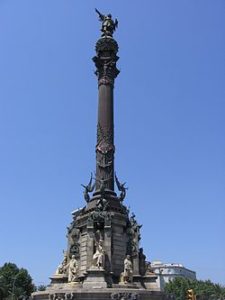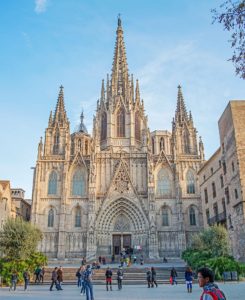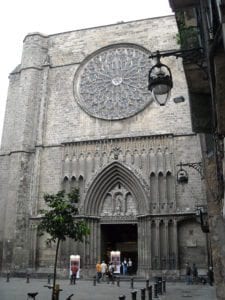This post is a self-guided tour of Barcelona's Old Town and Gothic Quarter. Use can use it to get around on your own or to discover what is here.
There are numerous guided tours that cover this important part of the city. Many of them are "free tours" or rather pay-what-you-wish.
These tours run daily in both English and Spanish. You can book them for free here.
Related Posts:
- Free Walking Tour of Barcelona
- Barcelona Bike Tours
- Top 10 Free Things to do in Barcelona
- Self-guided Barcelona Gaudí Tour
Self-Guided Gothic Tour of Barcelona
Colom Monument
This 47 m (155 ft.) monument to the world’s most famous sailor was built for Barcelona’s Universal Exposition of 1888.
Looking around the Port Vell (old port) area today you’ll get incredible views of the hill of Montjüic, Las Ramblas, ships in the harbor, and Roy Lichtenstein’s colorful Cap de Barcelona statue along Passeig de Colom.
But this would have looked very different in Columbus’s day when he returned from his first voyage to the New World and visited Barcelona in 1493.
Today everything here is modern, but this is where the Roman ships would’ve come aground when they founded the city of Barcino in 25 BC.
Begin walking up Las Ramblas past the human statues and you’ll see the medieval Drassanes shipyard on your left. This is now the maritime museum of Barcelona and a must for naval enthusiasts.
As you stroll up Las Ramblas, on your left you’ll pass Arts Santa Monica, a modern gallery for travelling contemporary art, the Teatro Principal (the oldest theatre in the city, founded in 1579), and the beautifully tiled building which houses El Cordobés, the oldest and best Flamenco Tablao in the city.
Palau Güell
Turn left on C/Nou de la Rambla and at no. 3-5 you’ll find your first Gaudí creation, Palau Güell.
Built by the city’s most famous architect for his rich patron Eusebi Güell between 1886 and 1888 as Barcelona was at the height of its industrial boom and about to host the Universal Exhibition.
This is the cheapest Gaudí house to visit as it’s the only one publicly owned.
As soon as you leave Las Ramblas you enter the Raval neighborhood. This notorious part of town was once the city’s red-light district and visitors would do well to watch their valuables in this area, especially at night. Return to Las Ramblas and almost immediately turn right for our next Gaudí piece.
Like a lot of the open spaces off of Las Ramblas, Plaça Reial was originally a convent but that was burned down in the anti-Catholic riots of 1835. The square was designed by Francesc Daniel Molina i Casamajó and is typical of Spanish plazas around the world. Can you see anything Gaudíesque here?
Many people miss them, but the colorful street lamps were designed by Antoni Gaudí. They were his first and only publicly funded work as he asked for more than the city fathers were willing to pay and spent years acrimoniously haggling over his fee!
There are many nice terraces for lunch or a snack in Plaça Reial though, be aware, the prices are much higher in and around Las Ramblas. For a night out, both Jamboree jazz and blues club, which later becomes a popular nightclub, and Sidecar rock club are worth a look.
Leave Plaça Reial by the arched entrance, on the left when you entered, and turn right on C/Ferran where you’ll pass lots of souvenir shops as you head up the gently sloping Mont Tabor hill where the Roman’s built their first settlement.
Plaça Sant Jaume
This is where the city is ruled from today. Barcelona is the capital of Catalunya an autonomous region within Spain with its own language, parliament and government. The Catalan government works out of the Palau de la Generalitat with its image of Saint George killing a dragon on the northern side of the square.
On the southern side of the square you’ll see the Adjuntament, or city hall. Inside here you’ll find the incredible gothic hall of the council of one hundred, who ruled the city during its first golden age in the 12th and 13th centuries. The Consell de Cent is open to visit on Sunday mornings and well worth a visit. On top of the city hall you’ll see the three flags of; Spain, Catalunya with it’s four red bars on a gold background, and Barcelona, split into four with the Catalan stripes and the white and red cross of Saint George, patron saint of the region.
Leave the square by the small C/Paradis on the upper corner of the square for a hidden gem.
Temple of Augustus
In a small dark corner of C/Paradis you’ll see an open doorway. Go into the courtyard and descend the steps on the right for a true hidden gem, the four huge Roman columns of the Temple of Augustus. When the Romans first ruled here they were not Christian and at the highest point of every city had a temple to their gods. Incredibly three of these columns had been built on top of over the years and ran through the floors and ceilings of several apartments before one resident, on seeing the forth column proudly displayed in Plaça de Reí, informed the authorities that he was living with an architectural gold mine! Be aware that the temple is closed on Mondays.
Continue on C/Paradis to the back of the Cathedral, turn right and down the hill into the Plaça del Reí.
Plaça de Reí

During the Middle Ages these Counts spread the city’s power, conquering neighboring lands and marrying into the royal line of the Crown of Aragón. In 1469 the most famous king of Aragón, Ferdinand, married Isabella of Castile famously bringing together the two biggest kingdoms on the peninsular. Ferdinand and Isabella also funded Christopher Columbus and you’ll see copies of their contracts with him on the walls inside the Archives of the Crown of Aragón as you leave the square through the Palau de Lloctinent.
Turn right as you head down to the front of the Cathedral. You’ll pass through Plaça del Iu with the Museu Frederic Mares, which used to be the Barcelona headquarters of the Spanish Inquisition.
The Cathedral
Head out into the bustling square in front of Barcelona Cathedral for the best views. The current building was begun in 1298 but took 150 years to build. The towers and ornate neo-gothic façade you see today were not added until the 19th Century in preparation for the Universal Exhibition.
The Cathedral is dedicated to Santa Eulalia the city’s first patron saint. It’s free to enter before midday and after 5pm. In the cloister, which will see soon, there are 13 geese to commemorate Santa Eulalia.
For now turn your back on the Cathedral and walk to the left.
Plaça Nova

Opposite the College of Architects you’ll see the entrance to the Roman city. Head up C/Bisbe and stop in Plaça Garriga i Bachs where you can enter the cloister of the Cathedral for free. Inside you’ll find 13 geese representing Santa Eulalia’s thirteen tortures at the hands of the Romans.
On leaving the cloisters take the small C/del Bisbe de Montjüic, on your right as you leave, and you’ll head to the perhaps the city’s most tragic and picturesque square.
Plaça Sant Felip Neri

The Civil War, and 40-year dictatorship that followed, remains a taboo subject with many Spanish people. Catalans remember it as a time when their language was suppressed and political dissent was heavily punished.
Leave the square by the only other exit and turn right and then immediately left into the Call.
The Jewish Quarter
You’ll have noticed how the streets around here are very thin and labyrinthine, they go back a long time and are known as call in Catalan. Here in Barcelona and Girona, they use the word call to refer to the Jewish Quarters. During the golden age of the Crown of Aragón 20% of Barcelona’s population was Jewish and this area would have had up to 5 synagogues. The tragic expulsion of the Jewish people happened early here in Barcelona than in the rest of Spain. In 1391 angry mobs attacked the call destroying the Jewish community.
Continue past the fantastic Zona d’Ombra wine war (If you can resist a pit-stop for a glass of local produce!), past the plaça and turn right on C/Marlet, where you’ll find what is believed to be one of the lost synagogues. Today the building is an information center and for a few euros they will give you a fascinating speech about the history of the building.
Continue down C/Marlet; turn left at the bottom and then right on C/del Call. Looking up to your right you’ll see the remains of the old arched entrance to the Jewish Quarter. At the bottom of the street turn right on C/Banys Nous. This was the street of the old Roman Baths, though there are no traces of those left today, you can get fantastic churros con chocolate to snack on from Xurreria Manuel San Román. Turn left on C/de l’Ave Maria and you’ll pop out into the Plaça Sant Josep Oriol at the side of Santa Maria del Pí.
Santa Maria del Pí
Original Catalan Gothic architecture tends to be less decorated and simpler than northern Gothic, and Santa Maria del Pí, begun in 1391, is no exception. Walk to the front of the church to see one of the most beautiful rose windows in the city. You can climb the church tower by day for breathtaking views of the Gothic Quarter, or enter the church later in the evening for one of their enchanting Spanish guitar shows.
On leaving Santa Maria del Pí turn left on C/del Cardenal Casañas.
Las Ramblas
You’ll arrive at Las Ramblas by 
Casting your eyes back down Las Ramblas, you might still be able to catch a glimpse of our old friend Columbus, but we’re going to head up Las Ramblas and end our tour right outside the city’s beating heart, the fabulous Sant Josep La Boquería food market.
After all this walking you deserve some rest and refueling, and what better place than an 800 year old market. La Boquería is named after the gateway where peasants first came in 1217 to sell their wares to Barcelona citizens without paying the taxes imposed inside the walls. Today you’ll find the place packed full of bars and restaurants, or, for a cheaper option, buy your own food and sit and eat in the little park behind the market.
This is the end of the tour, for a quick getaway the Liceu metro station on line 3 is right in front of the market. Enjoy Barcelona!




